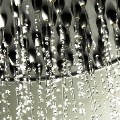
In Weak Housing Market, Some Homeowners Investing in Green
It’s a tough housing market. The nation is awash in anxiety over mortgage defaults, credit problems, debate over bailouts and haggling over the future of Fannie Mae and Freddie Mac.
People are staying in homes longer, rather than flipping houses, and they are now investing in their houses and buying bigger-ticket items. In a trend that at first seems counterintuitive given the weak housing market, many homeowners are spending considerable amounts of money in green building features, such as energy efficiency upgrades and non-toxic products.
More and more builders, designers, real estate agents and homeowners are discovering that going green can help them get a leg up in tough times, as well as substantially decrease our environmental footprints, from carbon emissions to water and land use. As more wealthy homeowners invest in green building, prices keep coming down, and trends percolate down to the middle classes — and eventually to low-income residences as well.
Fortunately for green, many of those new bigger-ticket items boast impressive eco-friendly advantages. Some of the hot green design trends include original antiques (which is a time-tested way of recycling), organic, non-toxic paints, wallpaper and upholstery, energy efficient appliances and countertops made of poured concrete or “lavastone,” instead of mining and energy-intensive granite.
Here are 5 Simple Money-Saving Green Remodeling Ideas:
1. Dodge Drafts and Seal Air Leaks
Perhaps one of the easiest ways to save money around the house is to seal off drafts, which can reduce your energy bills 5 to 30 percent, according to the U.S. Department of Energy.
2. Install a Programmable Thermostat
It may not be the most thrilling piece of electronics you could buy yourself, but a programmable thermostat will pay for itself in one season, and save you time and hassle.
3. Fix Those Water Leaks
A dripping faucet or pipe joint can really add up to substantial water waste. One faulty faucet wastes 3 gallons of water per day, reports the U.S. Geological Survey.
4. Install Low-Flow Showerheads and Toilets
It’s a fact that most older models waste large amounts of water. In fact, more than 30 percent of indoor residential water use is flushed down the porcelain throne.
5. Buy Energy Star Appliances
Look for the blue-and-white label, which means the item is at least 10 to 50 percent more efficient than standard models. That means lower energy bills and less pollution.